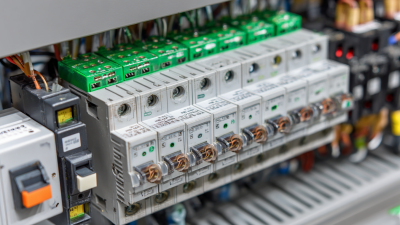How to Optimize Power Distribution Systems for Maximum Efficiency
In today’s rapidly evolving energy landscape, optimizing power distribution systems for maximum efficiency has become a critical focus for utilities and energy providers. As the demand for electricity continues to rise, it is essential to enhance the performance of power distribution networks to ensure reliable service while minimizing losses and costs.

This guide aims to provide insights into the strategies and technologies that can be employed to optimize power distribution systems. By adopting innovative solutions and best practices, stakeholders can significantly improve energy efficiency, reduce operational expenses, and ultimately contribute to a more sustainable energy future.
Understanding the dynamics of power distribution and implementing effective optimization techniques is crucial for meeting the challenges of modern energy demands and achieving long-term operational success.
Best Practices for Load Balancing in Power Distribution Systems
Load balancing in power distribution systems is crucial for ensuring optimal efficiency and reliability. According to a report by the International Energy Agency (IEA), inefficient load distribution can lead to energy losses of up to 20%. Implementing best practices in load balancing not only enhances system performance but also reduces operational costs. Real-time monitoring and advanced analytics are essential tools in this endeavor, enabling utilities to identify peak load times and adjust distribution accordingly.
One effective method for load balancing is the use of smart grid technologies. By integrating sensors and automated controls, utilities can dynamically redistribute power to prevent overloads and outages. A study by the Electric Power Research Institute (EPRI) found that utilities employing smart grid solutions experienced a 15% reduction in energy losses during peak demand periods. Additionally, employing predictive analytics can help forecast demand fluctuations, allowing for proactive adjustments that further optimize distribution efficiency. As the energy sector moves toward greater sustainability, focusing on load balancing will be increasingly important for enhancing overall system performance and reducing environmental impact.
Implementing Smart Grids for Enhanced Efficiency and Reliability
 Implementing smart grids is a revolutionary step towards enhancing efficiency and reliability in power distribution systems. Smart grids leverage advanced technology to create a more responsive and flexible electric grid, allowing for real-time monitoring and management of energy flow. This not only helps in reducing energy losses but also improves the integration of renewable energy sources. By using smart meters and sensors, utilities can collect data on energy consumption patterns, leading to more informed decision-making and optimized energy distribution.
Implementing smart grids is a revolutionary step towards enhancing efficiency and reliability in power distribution systems. Smart grids leverage advanced technology to create a more responsive and flexible electric grid, allowing for real-time monitoring and management of energy flow. This not only helps in reducing energy losses but also improves the integration of renewable energy sources. By using smart meters and sensors, utilities can collect data on energy consumption patterns, leading to more informed decision-making and optimized energy distribution.
Tip: Consider investing in technologies that facilitate two-way communication between the grid and consumers. This can empower users to adjust their energy usage based on real-time pricing, consequently reducing peak demand and promoting energy conservation.
Moreover, smart grids enhance reliability by quickly detecting and responding to outages or disturbances. Automated systems can reroute power and restore services much faster than traditional grids. This resilience is crucial in maintaining a steady power supply, especially during extreme weather conditions.
Tip: Collaborate with local stakeholders, including businesses and residents, to foster a culture of energy efficiency. Education programs can raise awareness about energy-saving practices, ultimately leading to a more sustainable community and better performance of the smart grid.
The Role of Energy Storage Systems in Optimizing Power Distribution
 Energy storage systems (ESS) play a crucial role in optimizing power distribution systems by enhancing resilience, stability, and overall efficiency. By storing excess energy generated during off-peak hours, these systems can alleviate pressure on the grid during peak demand times. This capability not only balances supply and demand but also reduces the need for additional power plants that often rely on fossil fuels. Implementing ESS can lead to significant savings in operational costs and a diminished carbon footprint.
Energy storage systems (ESS) play a crucial role in optimizing power distribution systems by enhancing resilience, stability, and overall efficiency. By storing excess energy generated during off-peak hours, these systems can alleviate pressure on the grid during peak demand times. This capability not only balances supply and demand but also reduces the need for additional power plants that often rely on fossil fuels. Implementing ESS can lead to significant savings in operational costs and a diminished carbon footprint.
Furthermore, advancements in battery technology, such as lithium-ion and flow batteries, have made energy storage more accessible and affordable than ever. These technologies provide flexibility in energy management, enabling utilities and businesses to strategically utilize stored energy based on real-time demand patterns. By integrating renewable energy sources with ESS, power distribution systems can become more sustainable, allowing for a smoother transition to greener alternatives while ensuring a reliable power supply. Consequently, the synergy between energy storage and power distribution not only improves efficiency but also supports the growth of a more resilient energy landscape.
Utilizing Real-Time Data Analytics to Improve System Performance
In today's rapidly evolving energy landscape, optimizing power distribution systems is crucial for achieving maximum efficiency. A vital component in this process is the utilization of real-time data analytics, which provides insights into system performance and reveals areas for improvement. By leveraging advanced analytics tools, utilities can monitor and analyze consumption patterns, forecast demand fluctuations, and identify operational inefficiencies.
**Tip:** Implement predictive maintenance strategies using real-time data to anticipate equipment failures before they occur. By doing so, you can minimize downtime and extend the lifespan of your assets.
Moreover, real-time data analytics enables power distribution companies to respond swiftly to changes in demand. This responsiveness not only ensures reliable service but also facilitates better resource allocation. By integrating smart grid technologies, utilities can harness data to optimize load distribution and enhance grid stability, ultimately leading to lower operational costs.
**Tip:** Consider adopting machine learning algorithms to analyze historical and real-time data. This approach can enhance decision-making by uncovering patterns that traditional methods might overlook.
Power Distribution Systems Efficiency Optimization
This chart illustrates the efficiency of power distribution systems across various regions, highlighting the impact of real-time data analytics on performance improvements.
Emerging Technologies for Enhanced Distribution Network Management
Emerging technologies are revolutionizing the management of distribution networks, paving the way for enhanced efficiency in power distribution systems.
One significant advancement is the implementation of smart grid technology, which integrates digital communication and control systems into the power distribution infrastructure.
This allows for real-time monitoring and management of electrical loads, enabling utilities to optimize energy delivery and reduce losses.
By utilizing advanced metering infrastructure (AMI), utilities can gain insights into usage patterns and respond rapidly to fluctuations in demand.
Another promising technology is the adoption of energy storage systems, such as batteries and pumped hydro storage.
These systems can store excess energy during low demand periods and release it during peak times, thus balancing supply and demand effectively.
Furthermore, the integration of renewable energy sources, like solar and wind, into the distribution network is facilitated by innovative grid management solutions that enhance reliability while ensuring a cleaner energy mix.
As these technologies continue to evolve, they offer opportunities to reduce operational costs and enhance the overall efficiency of power distribution systems.
Related Posts
-

How to Optimize Power Distribution Systems for Enhanced Efficiency and Safety
-

How to Choose the Right Electric Breaker for Optimal Safety and Efficiency
-

Understanding Challenges Faced with Electric Breaker Switches in Modern Applications
-

How to Select the Best Surge Protection Solutions for Your Business Needs
-

Common Issues with Electric Breakers: A Global Purchasing Insight
-

Ultimate Guide to Choosing the Right Surge Protection Circuit Breaker for Your Needs








